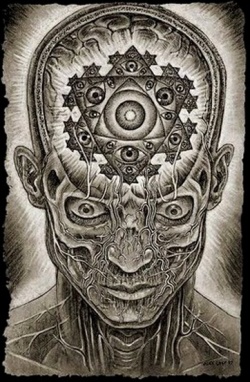Difference between revisions of "Aggregates"
| Line 1: | Line 1: | ||
[[File:Skandhas 01.jpg|thumb|250px|]] | [[File:Skandhas 01.jpg|thumb|250px|]] | ||
| − | '''[[Aggregates]]''': [[Sanskrit]]: [[Skandha]]. [[Tibetan]]: [[phung po]]. The [[components of the psycho-social personality]] by which [[beings]] impute the false notion of [[self]]; the [[five components of the individual existence]]: | + | '''[[Aggregates]]''': [[Sanskrit]]: [[Skandha]]. [[Tibetan]]: [[phung po]]. The [[components of the psycho-social personality]] by which [[beings]] impute the false notion of [[self]]; the [[five components of the individual existence]]: |
| + | |||
| + | [[aggregates]]: [[Sanskrit]]: [[skandha]]. [[Tibetan]]: [[phung po]]. The [[components of the psycho-social personality]] by which [[beings]] impute the false notion of [[self]]; the [[five components of the individual existence]]: | ||
| + | |||
| + | 1. [[Form]] ({{Wiki|matter}}): (S. [[rupa]], T. zug) The [[physical body]], [[mind]] and of [[sense organs]]. The [[body]] is thus analyzed in terms of the [[five elements]]: [[space]], {{Wiki|solidity}}, [[fluidity]], {{Wiki|motion}}, and heat. | ||
| + | |||
| + | 2. [[Sensation]]: (S. [[vedana]], T. tsor wa) Analyzed in terms of the [[sense organs]], [[feelings]] are of three {{Wiki|distinct}} kinds: [[pleasant]], [[unpleasant]] or [[neutral]]. The [[mind]] is considered a [[sense organ]]. | ||
| + | |||
| + | 3. [[Perception]]: The relationship between outer [[forms]] presented by the [[five sense organs]] and the inner [[mind]] through the process of naming and categorization; the interaction between [[mind]], [[sense organs and their objects]] gives rise to [[feelings]] which are further qualified by [[perception]]. | ||
| + | |||
| + | 4. [[Mental Formation]]: This includes all of the willed [[actions]] of the [[mind]]. This is the [[skandha]] associated with [[Wikipedia:Volition (psychology)|volition]] and the formation of new [[karmas]]. | ||
| + | |||
| + | 5. [[Consciousness]]: (S. [[vijnana]], T. nam par she pa)The resultant [[moment]] of [[conditional]] [[awareness]] which arises when suitable [[conditions]] conspire. When the [[mind]] makes [[contact]] with an [[object]] simple read-out [[awareness]] arises as a result of the [[contact]]. | ||
| + | |||
| + | The [[Buddha]] [[taught]] that [[consciousness]] does not arise without [[conditions]]. These [[conditions]] are brought into the {{Wiki|present}} through the {{Wiki|mechanism}} of the first four [[skandhas]]. | ||
{{R}} | {{R}} | ||
[[Category:Buddhist Terms]] | [[Category:Buddhist Terms]] | ||
[[Category:Aggregates]] | [[Category:Aggregates]] | ||
Revision as of 09:06, 8 November 2015
Aggregates: Sanskrit: Skandha. Tibetan: phung po. The components of the psycho-social personality by which beings impute the false notion of self; the five components of the individual existence:
aggregates: Sanskrit: skandha. Tibetan: phung po. The components of the psycho-social personality by which beings impute the false notion of self; the five components of the individual existence:
1. Form (matter): (S. rupa, T. zug) The physical body, mind and of sense organs. The body is thus analyzed in terms of the five elements: space, solidity, fluidity, motion, and heat.
2. Sensation: (S. vedana, T. tsor wa) Analyzed in terms of the sense organs, feelings are of three distinct kinds: pleasant, unpleasant or neutral. The mind is considered a sense organ.
3. Perception: The relationship between outer forms presented by the five sense organs and the inner mind through the process of naming and categorization; the interaction between mind, sense organs and their objects gives rise to feelings which are further qualified by perception.
4. Mental Formation: This includes all of the willed actions of the mind. This is the skandha associated with volition and the formation of new karmas.
5. Consciousness: (S. vijnana, T. nam par she pa)The resultant moment of conditional awareness which arises when suitable conditions conspire. When the mind makes contact with an object simple read-out awareness arises as a result of the contact.
The Buddha taught that consciousness does not arise without conditions. These conditions are brought into the present through the mechanism of the first four skandhas.
